Abstract
Phenylketonuria (PKU), a disorder of amino acid metabolism prevalent among Caucasians and other ethnic groups, is caused primarily by a deficiency of the hepatic enzyme phenylalanine hydroxylase (PAH). PKU is a highly heterogeneous disorder, with more than 60 molecular lesions identified in the PAH gene. The haplotype associations, relative frequencies, and distributions of five prevalent PAH mutations (R158Q, R261Q, IVS10nt546, R408W, and IVS12nt1) were established in a comprehensive European sample population and subsequently were examined to determine the potential roles of several genetic mechanisms in explaining the present distribution of the major PKU alleles. Each of these five mutations was strongly associated with only one of the more than 70 chromosomal haplotypes defined by eight RFLPs in or near the PAH gene. These findings suggest that each of these mutations arose through a single founding event that occurred within time periods ranging from several hundred to several thousand years ago. From the significant differences observed in the relative frequencies and distributions of these five alleles throughout Europe, four of these putative founding events could be localized to specific ethnic subgroups. Together, these data suggest that there were multiple, geographically and ethnically distinct origins for PKU within the European population.
Full text
PDF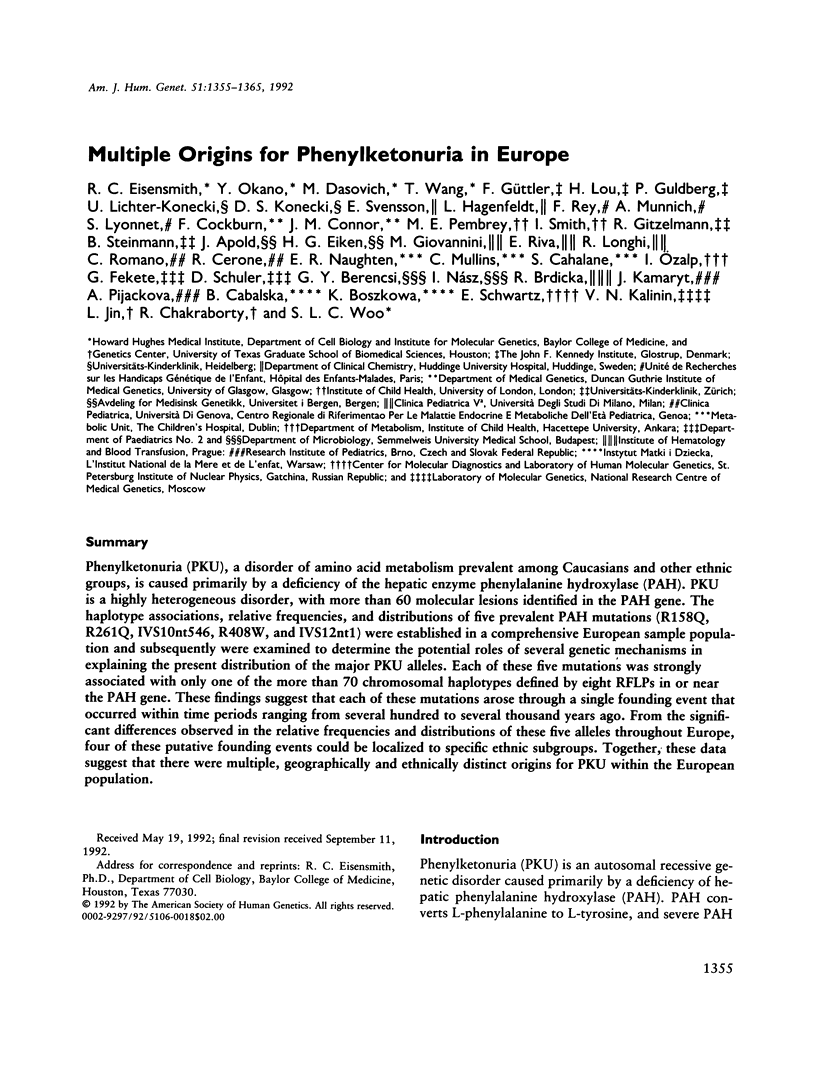
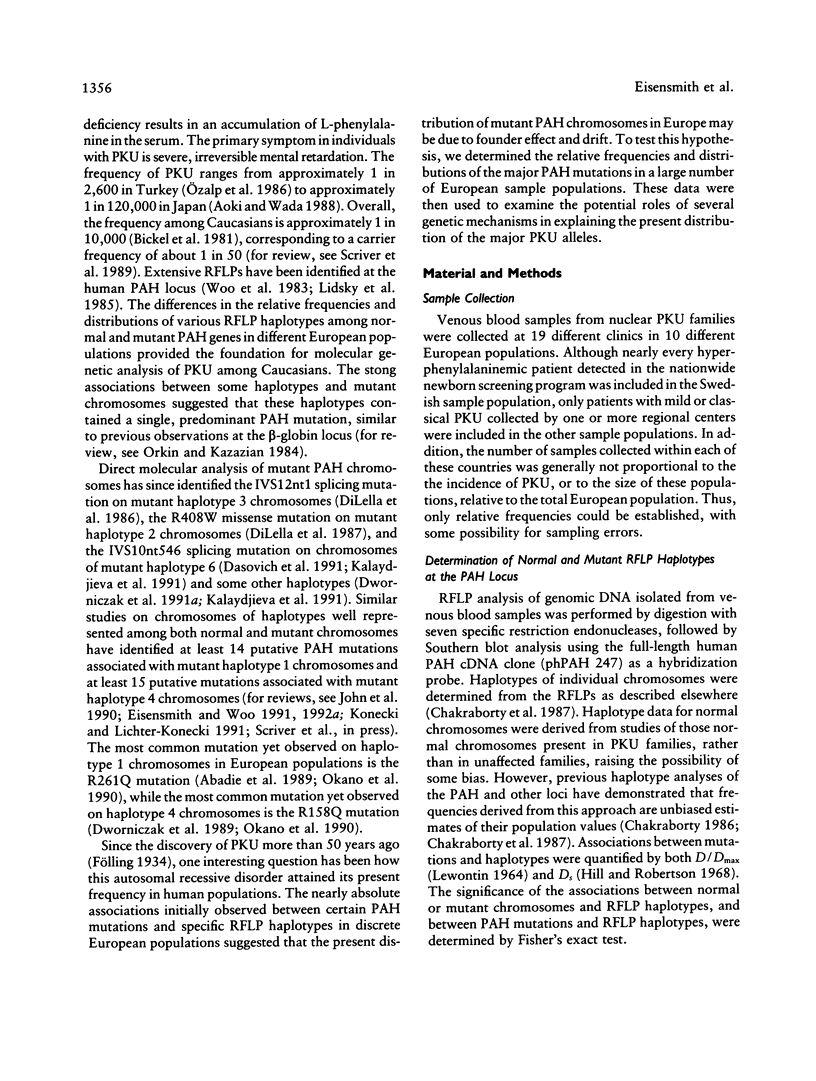
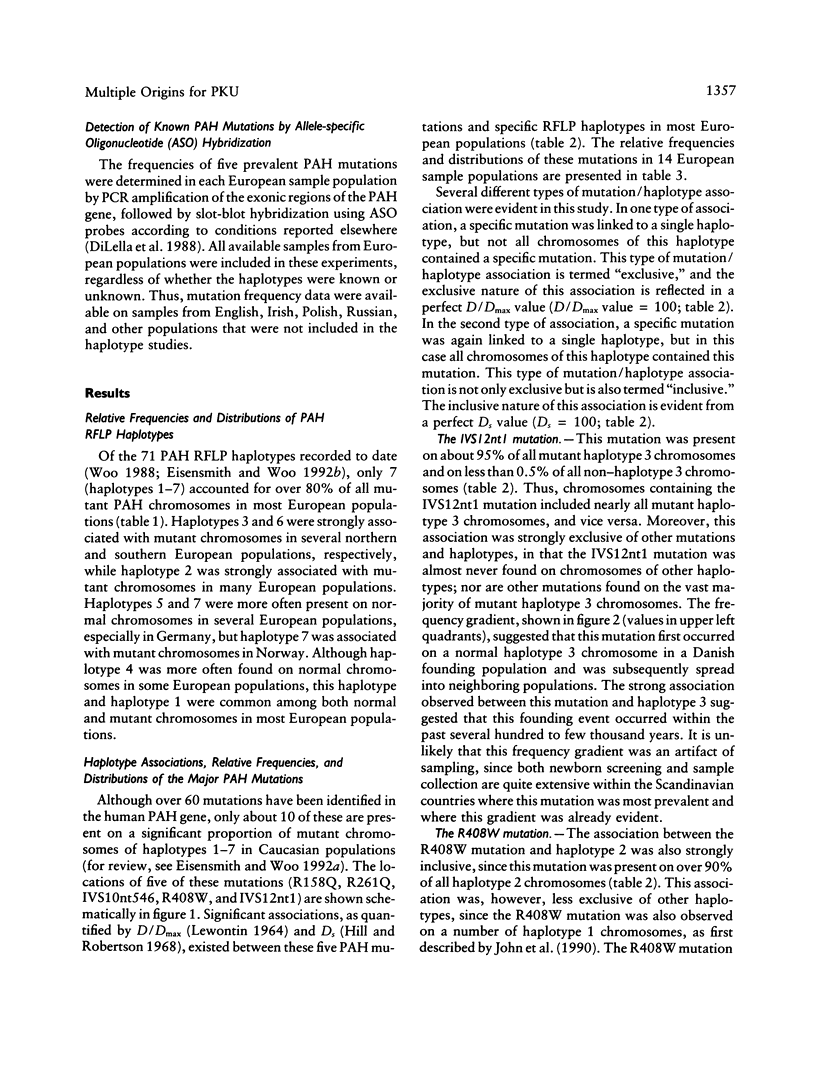
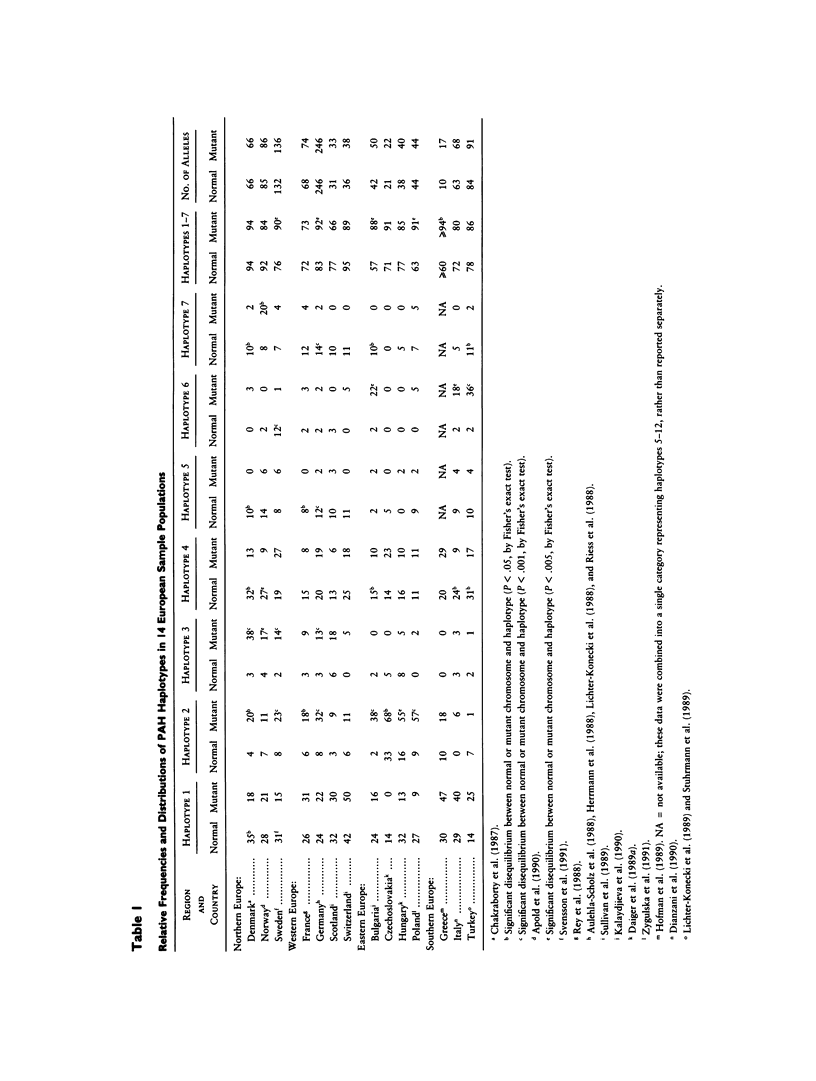
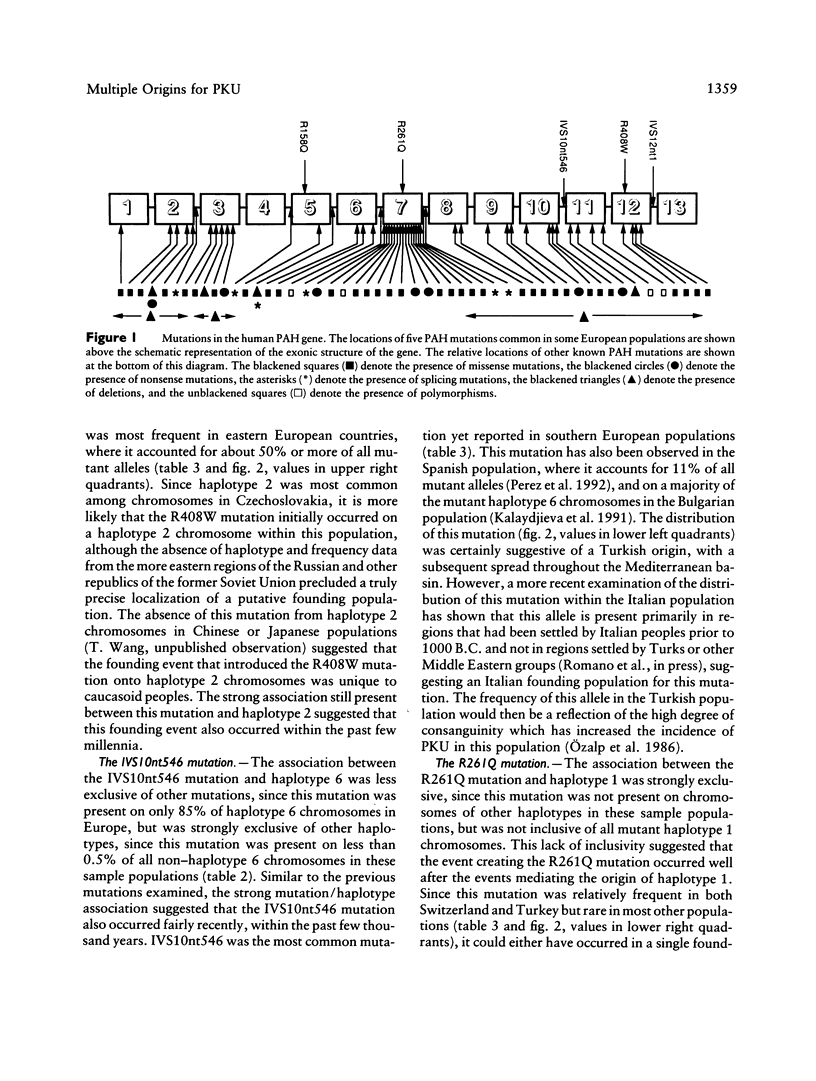
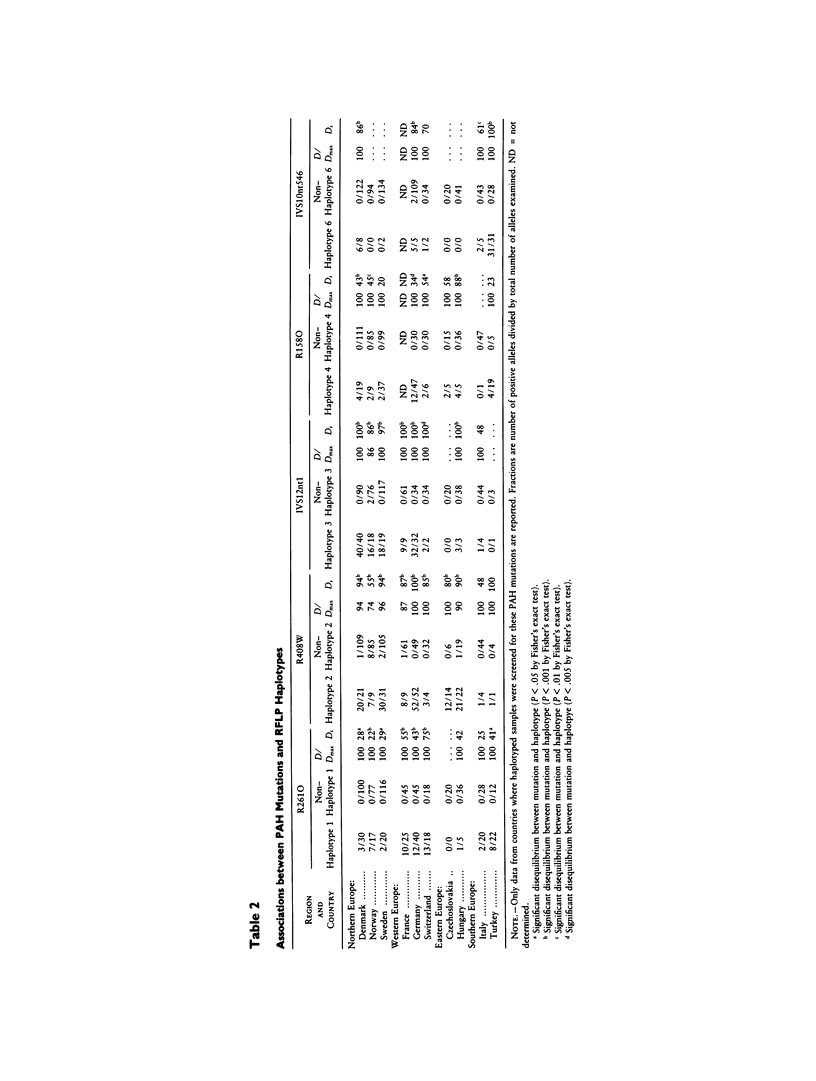
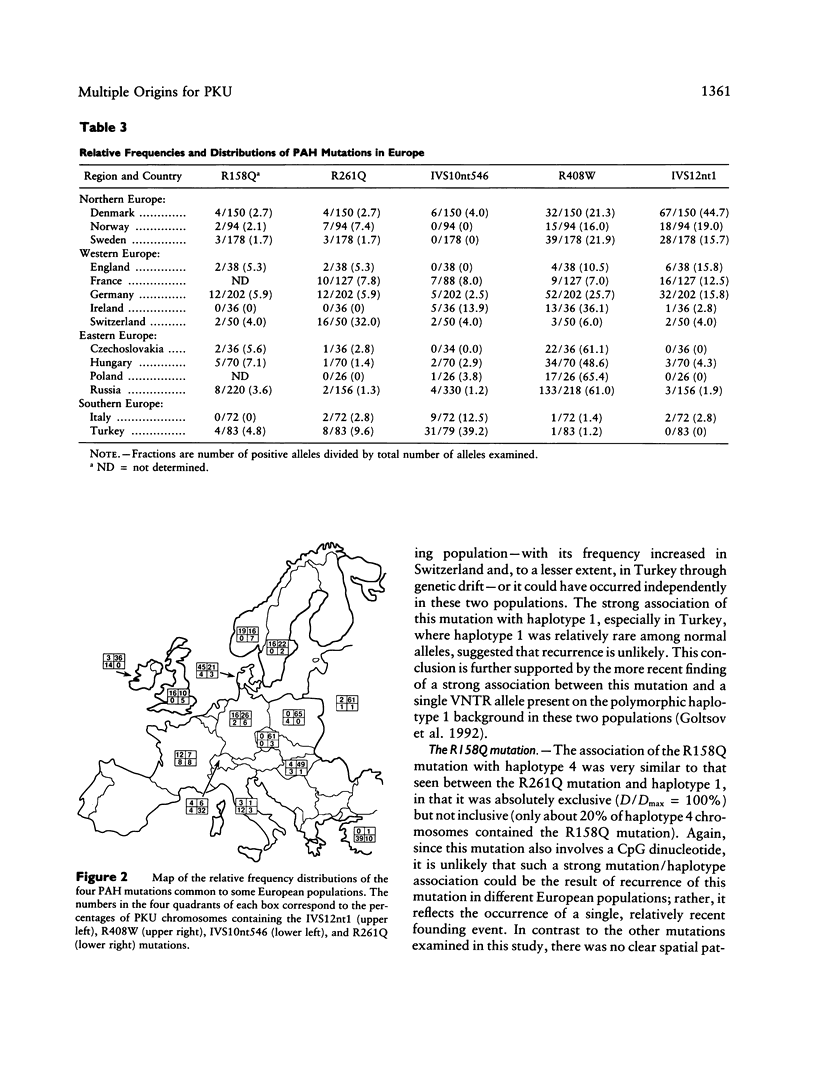
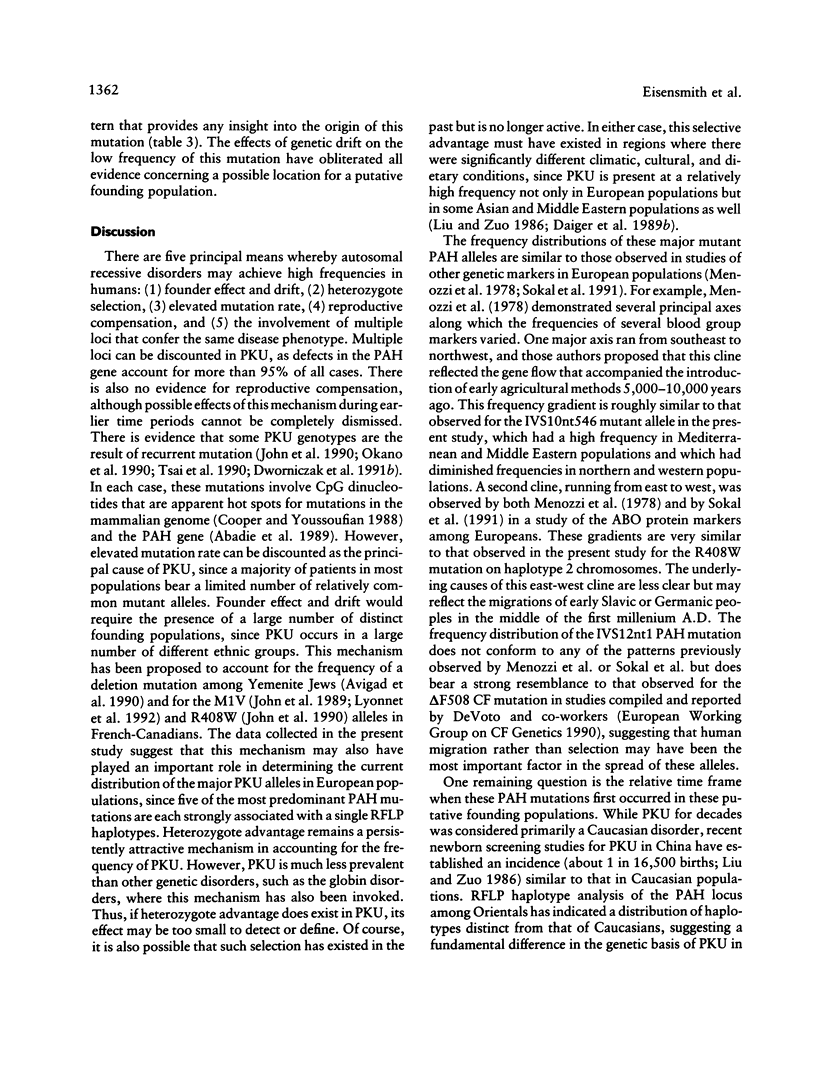
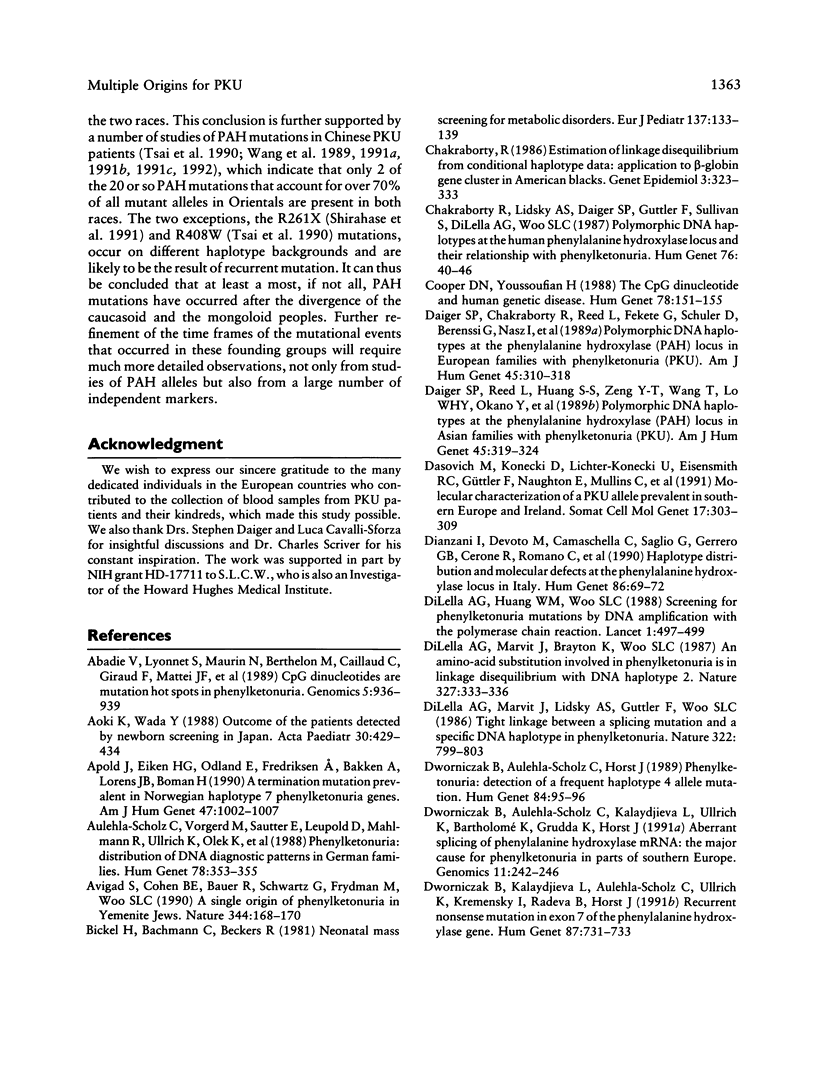
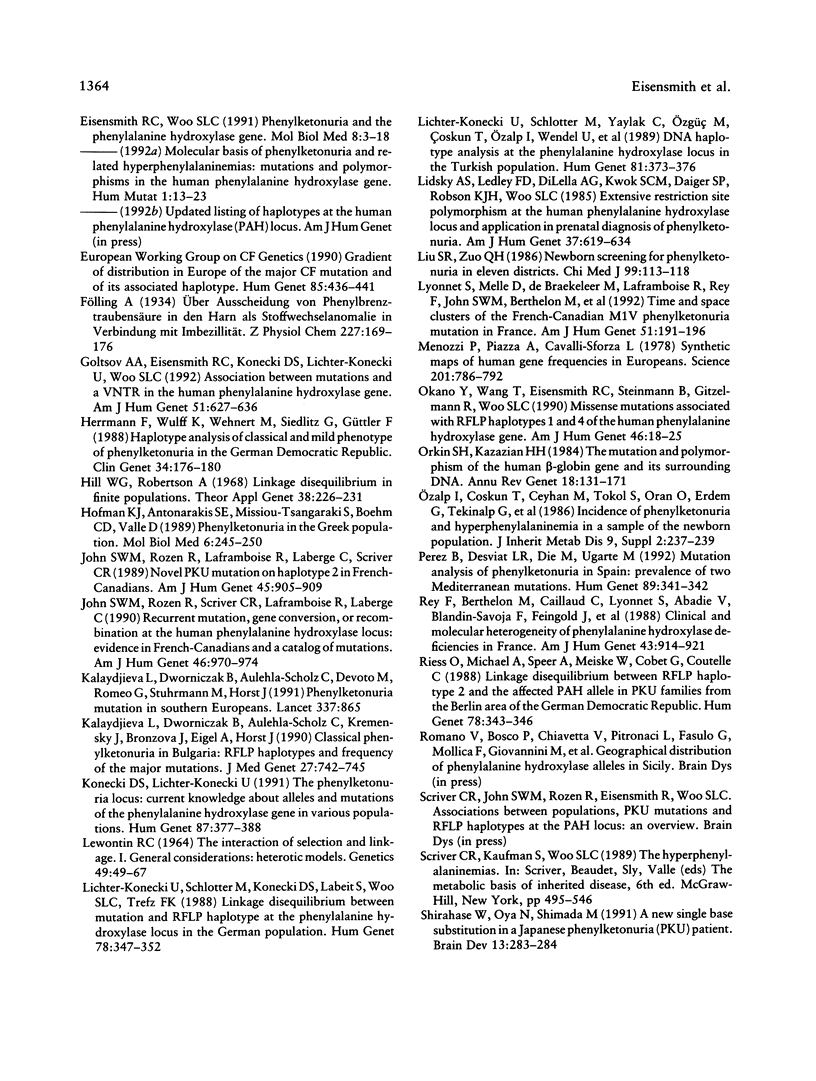
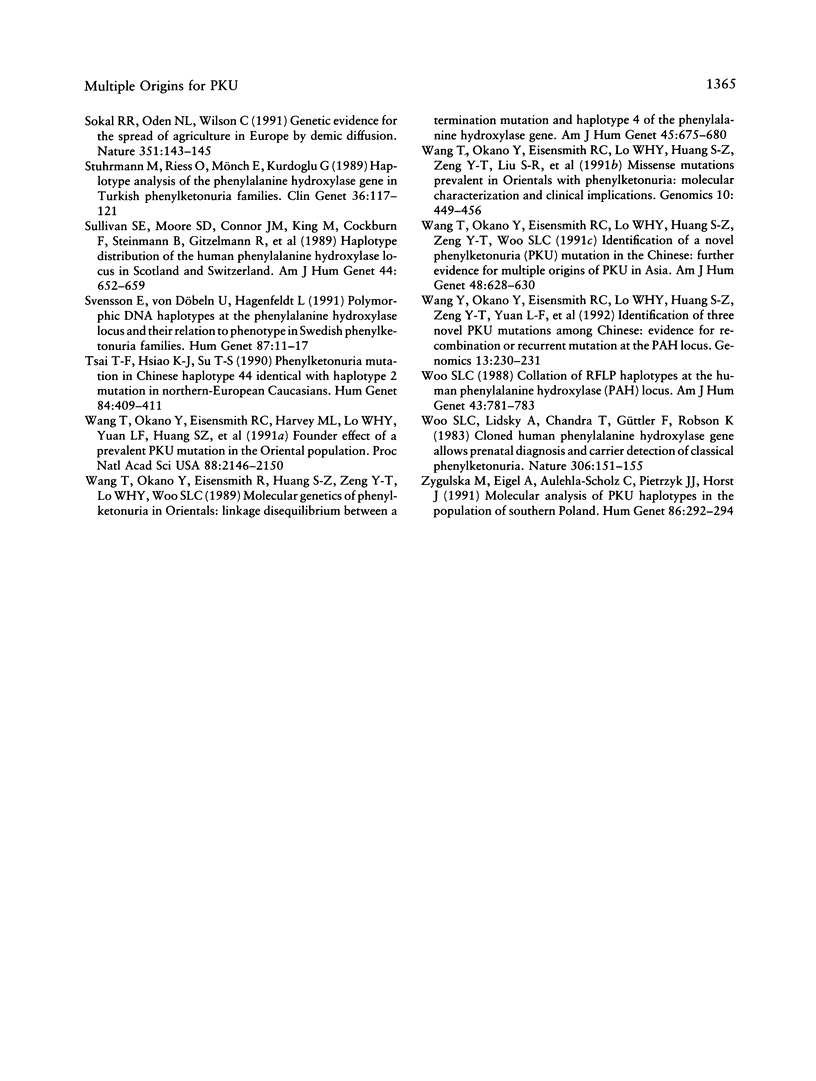
Selected References
These references are in PubMed. This may not be the complete list of references from this article.
- Abadie V., Lyonnet S., Maurin N., Berthelon M., Caillaud C., Giraud F., Mattei J. F., Rey J., Rey F., Munnich A. CpG dinucleotides are mutation hot spots in phenylketonuria. Genomics. 1989 Nov;5(4):936–939. doi: 10.1016/0888-7543(89)90137-7. [DOI] [PubMed] [Google Scholar]
- Aoki K., Wada Y. Outcome of the patients detected by newborn screening in Japan. Acta Paediatr Jpn. 1988 Aug;30(4):429–434. doi: 10.1111/j.1442-200x.1988.tb02533.x. [DOI] [PubMed] [Google Scholar]
- Apold J., Eiken H. G., Odland E., Fredriksen A., Bakken A., Lorens J. B., Boman H. A termination mutant prevalent in Norwegian haplotype 7 phenylketonuria genes. Am J Hum Genet. 1990 Dec;47(6):1002–1007. [PMC free article] [PubMed] [Google Scholar]
- Aulehla-Scholz C., Vorgerd M., Sautter E., Leupold D., Mahlmann R., Ullrich K., Olek K., Horst J. Phenylketonuria: distribution of DNA diagnostic patterns in German families. Hum Genet. 1988 Apr;78(4):353–355. doi: 10.1007/BF00291734. [DOI] [PubMed] [Google Scholar]
- Avigad S., Cohen B. E., Bauer S., Schwartz G., Frydman M., Woo S. L., Niny Y., Shiloh Y. A single origin of phenylketonuria in Yemenite Jews. Nature. 1990 Mar 8;344(6262):168–170. doi: 10.1038/344168a0. [DOI] [PubMed] [Google Scholar]
- Chakraborty R. Estimation of linkage disequilibrium from conditional haplotype data: application to beta-globin gene cluster in American blacks. Genet Epidemiol. 1986;3(5):323–333. doi: 10.1002/gepi.1370030505. [DOI] [PubMed] [Google Scholar]
- Chakraborty R., Lidsky A. S., Daiger S. P., Güttler F., Sullivan S., Dilella A. G., Woo S. L. Polymorphic DNA haplotypes at the human phenylalanine hydroxylase locus and their relationship with phenylketonuria. Hum Genet. 1987 May;76(1):40–46. doi: 10.1007/BF00283048. [DOI] [PubMed] [Google Scholar]
- Cooper D. N., Youssoufian H. The CpG dinucleotide and human genetic disease. Hum Genet. 1988 Feb;78(2):151–155. doi: 10.1007/BF00278187. [DOI] [PubMed] [Google Scholar]
- Daiger S. P., Chakraborty R., Reed L., Fekete G., Schuler D., Berenssi G., Nasz I., Brdicka R., Kamarýt J., Pijácková A. Polymorphic DNA haplotypes at the phenylalanine hydroxylase (PAH) locus in European families with phenylketonuria (PKU). Am J Hum Genet. 1989 Aug;45(2):310–318. [PMC free article] [PubMed] [Google Scholar]
- Daiger S. P., Reed L., Huang S. S., Zeng Y. T., Wang T., Lo W. H., Okano Y., Hase Y., Fukuda Y., Oura T. Polymorphic DNA haplotypes at the phenylalanine hydroxylase (PAH) locus in Asian families with phenylketonuria (PKU). Am J Hum Genet. 1989 Aug;45(2):319–324. [PMC free article] [PubMed] [Google Scholar]
- Dasovich M., Konecki D., Lichter-Konecki U., Eisensmith R. C., Güttler F., Naughton E., Mullins C., Giovannini M., Riva E., Woo S. L. Molecular characterization of PKU allele prevalent in southern Europe and Ireland. Somat Cell Mol Genet. 1991 May;17(3):303–309. doi: 10.1007/BF01232824. [DOI] [PubMed] [Google Scholar]
- DiLella A. G., Huang W. M., Woo S. L. Screening for phenylketonuria mutations by DNA amplification with the polymerase chain reaction. Lancet. 1988 Mar 5;1(8584):497–499. doi: 10.1016/s0140-6736(88)91295-0. [DOI] [PubMed] [Google Scholar]
- DiLella A. G., Marvit J., Brayton K., Woo S. L. An amino-acid substitution involved in phenylketonuria is in linkage disequilibrium with DNA haplotype 2. 1987 May 28-Jun 3Nature. 327(6120):333–336. doi: 10.1038/327333a0. [DOI] [PubMed] [Google Scholar]
- DiLella A. G., Marvit J., Lidsky A. S., Güttler F., Woo S. L. Tight linkage between a splicing mutation and a specific DNA haplotype in phenylketonuria. 1986 Aug 28-Sep 3Nature. 322(6082):799–803. doi: 10.1038/322799a0. [DOI] [PubMed] [Google Scholar]
- Dianzani I., Devoto M., Camaschella C., Saglio G., Ferrero G. B., Cerone R., Romano C., Romeo G., Giovannini M., Riva E. Haplotype distribution and molecular defects at the phenylalanine hydroxylase locus in Italy. Hum Genet. 1990 Nov;86(1):69–72. doi: 10.1007/BF00205176. [DOI] [PubMed] [Google Scholar]
- Dworniczak B., Aulehla-Scholz C., Horst J. Phenylketonuria: detection of a frequent haplotype 4 allele mutation. Hum Genet. 1989 Dec;84(1):95–96. doi: 10.1007/BF00210683. [DOI] [PubMed] [Google Scholar]
- Dworniczak B., Aulehla-Scholz C., Kalaydjieva L., Bartholomé K., Grudda K., Horst J. Aberrant splicing of phenylalanine hydroxylase mRNA: the major cause for phenylketonuria in parts of southern Europe. Genomics. 1991 Oct;11(2):242–246. doi: 10.1016/0888-7543(91)90129-3. [DOI] [PubMed] [Google Scholar]
- Dworniczak B., Kalaydjieva L., Aulehla-Scholz C., Ullrich K., Kremensky I., Radeva B., Horst J. Recurrent nonsense mutation in exon 7 of the phenylalanine hydroxylase gene. Hum Genet. 1991 Oct;87(6):731–733. doi: 10.1007/BF00201735. [DOI] [PubMed] [Google Scholar]
- Eisensmith R. C., Woo S. L. Phenylketonuria and the phenylalanine hydroxylase gene. Mol Biol Med. 1991 Feb;8(1):3–18. [PubMed] [Google Scholar]
- Goltsov A. A., Eisensmith R. C., Konecki D. S., Lichter-Konecki U., Woo S. L. Associations between mutations and a VNTR in the human phenylalanine hydroxylase gene. Am J Hum Genet. 1992 Sep;51(3):627–636. [PMC free article] [PubMed] [Google Scholar]
- Herrmann F. H., Wulff K., Wehnert M., Seidlitz G., Güttler F. Haplotype analysis of classical and mild phenotype of phenylketonuria in the German Democratic Republic. Clin Genet. 1988 Sep;34(3):176–180. doi: 10.1111/j.1399-0004.1988.tb02859.x. [DOI] [PubMed] [Google Scholar]
- Hofman K. J., Antonarakis S. E., Missiou-Tsangaraki S., Boehm C. D., Valle D. Phenylketonuria in the Greek population. Haplotype analysis of the phenylalanine hydroxylase gene and identification of a PKU mutation. Mol Biol Med. 1989 Jun;6(3):245–250. [PubMed] [Google Scholar]
- John S. W., Rozen R., Laframboise R., Laberge C., Scriver C. R. Novel PKU mutation on haplotype 2 in French-Canadians. Am J Hum Genet. 1989 Dec;45(6):905–909. [PMC free article] [PubMed] [Google Scholar]
- John S. W., Rozen R., Scriver C. R., Laframboise R., Laberge C. Recurrent mutation, gene conversion, or recombination at the human phenylalanine hydroxylase locus: evidence in French-Canadians and a catalog of mutations. Am J Hum Genet. 1990 May;46(5):970–974. [PMC free article] [PubMed] [Google Scholar]
- Kalaydjieva L., Dworniczak B., Aulehla-Scholz C., Devoto M., Romeo G., Stuhrmann M., Horst J. Phenylketonuria mutation in southern Europeans. Lancet. 1991 Apr 6;337(8745):865–865. doi: 10.1016/0140-6736(91)92584-o. [DOI] [PubMed] [Google Scholar]
- Kalaydjieva L., Dworniczak B., Aulehla-Scholz C., Kremensky I., Bronzova J., Eigel A., Horst J. Classical phenylketonuria in Bulgaria: RFLP haplotypes and frequency of the major mutations. J Med Genet. 1990 Dec;27(12):742–745. doi: 10.1136/jmg.27.12.742. [DOI] [PMC free article] [PubMed] [Google Scholar]
- Konecki D. S., Lichter-Konecki U. The phenylketonuria locus: current knowledge about alleles and mutations of the phenylalanine hydroxylase gene in various populations. Hum Genet. 1991 Aug;87(4):377–388. doi: 10.1007/BF00197152. [DOI] [PubMed] [Google Scholar]
- Lewontin R C. The Interaction of Selection and Linkage. I. General Considerations; Heterotic Models. Genetics. 1964 Jan;49(1):49–67. doi: 10.1093/genetics/49.1.49. [DOI] [PMC free article] [PubMed] [Google Scholar]
- Lichter-Konecki U., Schlotter M., Konecki D. S., Labeit S., Woo S. L., Trefz F. K. Linkage disequilibrium between mutation and RFLP haplotype at the phenylalanine hydroxylase locus in the German population. Hum Genet. 1988 Apr;78(4):347–352. doi: 10.1007/BF00291733. [DOI] [PubMed] [Google Scholar]
- Lichter-Konecki U., Schlotter M., Yaylak C., Ozgü M., Coskun T., Ozalp I., Wendel U., Batzler U., Trefz F. K., Konecki D. DNA haplotype analysis at the phenylalanine hydroxylase locus in the Turkish population. Hum Genet. 1989 Mar;81(4):373–376. doi: 10.1007/BF00283695. [DOI] [PubMed] [Google Scholar]
- Lidsky A. S., Ledley F. D., DiLella A. G., Kwok S. C., Daiger S. P., Robson K. J., Woo S. L. Extensive restriction site polymorphism at the human phenylalanine hydroxylase locus and application in prenatal diagnosis of phenylketonuria. Am J Hum Genet. 1985 Jul;37(4):619–634. [PMC free article] [PubMed] [Google Scholar]
- Liu S. R., Zuo Q. H. Newborn screening for phenylketonuria in eleven districts. Chin Med J (Engl) 1986 Feb;99(2):113–118. [PubMed] [Google Scholar]
- Lyonnet S., Melle D., de Braekeleer M., Laframboise R., Rey F., John S. W., Berthelon M., Berthelot J., Journel H., Le Marec B. Time and space clusters of the French-Canadian M1V phenylketonuria mutation in France. Am J Hum Genet. 1992 Jul;51(1):191–196. [PMC free article] [PubMed] [Google Scholar]
- Menozzi P., Piazza A., Cavalli-Sforza L. Synthetic maps of human gene frequencies in Europeans. Science. 1978 Sep 1;201(4358):786–792. doi: 10.1126/science.356262. [DOI] [PubMed] [Google Scholar]
- Okano Y., Wang T., Eisensmith R. C., Steinmann B., Gitzelmann R., Woo S. L. Missense mutations associated with RFLP haplotypes 1 and 4 of the human phenylalanine hydroxylase gene. Am J Hum Genet. 1990 Jan;46(1):18–25. [PMC free article] [PubMed] [Google Scholar]
- Orkin S. H., Kazazian H. H., Jr The mutation and polymorphism of the human beta-globin gene and its surrounding DNA. Annu Rev Genet. 1984;18:131–171. doi: 10.1146/annurev.ge.18.120184.001023. [DOI] [PubMed] [Google Scholar]
- Pérez B., Desviat L. R., Die M., Ugarte M. Mutation analysis of phenylketonuria in Spain: prevalence of two Mediterranean mutations. Hum Genet. 1992 May;89(3):341–342. doi: 10.1007/BF00220555. [DOI] [PubMed] [Google Scholar]
- Rey F., Berthelon M., Caillaud C., Lyonnet S., Abadie V., Blandin-Savoja F., Feingold J., Saudubray J. M., Frézal J., Munnich A. Clinical and molecular heterogeneity of phenylalanine hydroxylase deficiencies in France. Am J Hum Genet. 1988 Dec;43(6):914–921. [PMC free article] [PubMed] [Google Scholar]
- Riess O., Michel A., Speer A., Meiske W., Cobet G., Coutelle C. Linkage disequilibrium between RFLP haplotype 2 and the affected PAH allele in PKU families from the Berlin area of the German Democratic Republic. Hum Genet. 1988 Apr;78(4):343–346. doi: 10.1007/BF00291732. [DOI] [PubMed] [Google Scholar]
- Shirahase W., Oya N., Shimada M. A new single base substitution in a Japanese phenylketonuria (PKU) patient. Brain Dev. 1991 Jul;13(4):283–284. doi: 10.1016/s0387-7604(12)80064-7. [DOI] [PubMed] [Google Scholar]
- Sokal R. R., Oden N. L., Wilson C. Genetic evidence for the spread of agriculture in Europe by demic diffusion. Nature. 1991 May 9;351(6322):143–145. doi: 10.1038/351143a0. [DOI] [PubMed] [Google Scholar]
- Stuhrmann M., Riess O., Mönch E., Kurdoglu G. Haplotype analysis of the phenylalanine hydroxylase gene in Turkish phenylketonuria families. Clin Genet. 1989 Aug;36(2):117–121. doi: 10.1111/j.1399-0004.1989.tb03173.x. [DOI] [PubMed] [Google Scholar]
- Sullivan S. E., Moore S. D., Connor J. M., King M., Cockburn F., Steinmann B., Gitzelmann R., Daiger S. P., Woo S. L. Haplotype distribution of the human phenylalanine hydroxylase locus in Scotland and Switzerland. Am J Hum Genet. 1989 May;44(5):652–659. [PMC free article] [PubMed] [Google Scholar]
- Svensson E., von Döbeln U., Hagenfeldt L. Polymorphic DNA haplotypes at the phenylalanine hydroxylase locus and their relation to phenotype in Swedish phenylketonuria families. Hum Genet. 1991 May;87(1):11–17. doi: 10.1007/BF01213084. [DOI] [PubMed] [Google Scholar]
- Tsai T. F., Hsiao K. J., Su T. S. Phenylketonuria mutation in Chinese haplotype 44 identical with haplotype 2 mutation in northern-European Caucasians. Hum Genet. 1990 Apr;84(5):409–411. doi: 10.1007/BF00195810. [DOI] [PubMed] [Google Scholar]
- Wang T., Okano Y., Eisensmith R. C., Harvey M. L., Lo W. H., Huang S. Z., Zeng Y. T., Yuan L. F., Furuyama J. I., Oura T. Founder effect of a prevalent phenylketonuria mutation in the Oriental population. Proc Natl Acad Sci U S A. 1991 Mar 15;88(6):2146–2150. doi: 10.1073/pnas.88.6.2146. [DOI] [PMC free article] [PubMed] [Google Scholar]
- Wang T., Okano Y., Eisensmith R. C., Lo W. H., Huang S. Z., Zeng Y. T., Woo S. L. Identification of a novel phenylketonuria (PKU) mutation in the Chinese: further evidence for multiple origins of PKU in Asia. Am J Hum Genet. 1991 Mar;48(3):628–630. [PMC free article] [PubMed] [Google Scholar]
- Wang T., Okano Y., Eisensmith R. C., Lo W. H., Huang S. Z., Zeng Y. T., Yuan L. F., Liu S. R., Woo S. L. Identification of three novel PKU mutations among Chinese: evidence for recombination or recurrent mutation at the PAH locus. Genomics. 1992 May;13(1):230–231. doi: 10.1016/0888-7543(92)90229-l. [DOI] [PubMed] [Google Scholar]
- Wang T., Okano Y., Eisensmith R. C., Lo W. H., Huang S. Z., Zeng Y. T., Yuan L. F., Liu S. R., Woo S. L. Missense mutations prevalent in Orientals with phenylketonuria: molecular characterization and clinical implications. Genomics. 1991 Jun;10(2):449–456. doi: 10.1016/0888-7543(91)90331-8. [DOI] [PubMed] [Google Scholar]
- Wang T., Okano Y., Eisensmith R., Huang S. Z., Zeng Y. T., Lo W. H., Woo S. L. Molecular genetics of phenylketonuria in Orientals: linkage disequilibrium between a termination mutation and haplotype 4 of the phenylalanine hydroxylase gene. Am J Hum Genet. 1989 Nov;45(5):675–680. [PMC free article] [PubMed] [Google Scholar]
- Woo S. L. Collation of RFLP haplotypes at the human phenylalanine hydroxylase (PAH) locus. Am J Hum Genet. 1988 Nov;43(5):781–783. [PMC free article] [PubMed] [Google Scholar]
- Woo S. L., Lidsky A. S., Güttler F., Chandra T., Robson K. J. Cloned human phenylalanine hydroxylase gene allows prenatal diagnosis and carrier detection of classical phenylketonuria. Nature. 1983 Nov 10;306(5939):151–155. doi: 10.1038/306151a0. [DOI] [PubMed] [Google Scholar]
- Zygulska M., Eigel A., Aulehla-Scholz C., Pietrzyk J. J., Horst J. Molecular analysis of PKU haplotypes in the population of southern Poland. Hum Genet. 1991 Jan;86(3):292–294. doi: 10.1007/BF00202412. [DOI] [PubMed] [Google Scholar]


